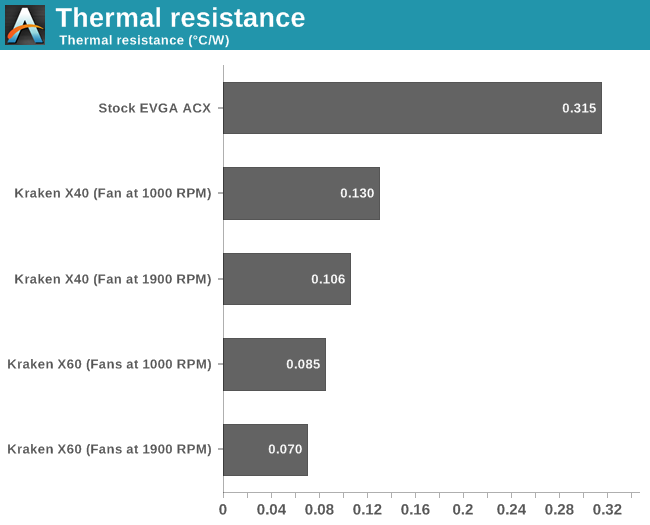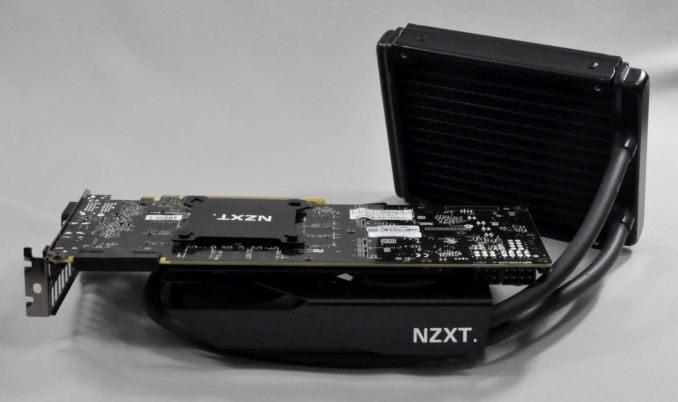NZXT Kraken G10 Review: Liquid Cooling for Your GPU
by E. Fylladitakis on March 11, 2014 1:15 AM EST- Posted in
- Cases/Cooling/PSUs
- NZXT
- Water Cooling
- Kraken
- G10
Performance Results
In order to assess the potential of the Kraken G10, we tested it on an EVGA GTX 770 ACX, a high performance graphics card with a good stock air-cooling solution. Testing is performed with the two cooling kits NZXT currently offers, the Kraken X40 (single 140mm) and the Kraken X60 (dual 140mm). In order to stress the GPU core to the maximum, we ran a cryptocoin mining algorithm at maximum intensity and allocation, a method that displayed considerably greater power draw (224W) than any 3D benchmark (≈174W during a Unigine Heaven run). It has the added benefit of being rather consistent in it's load.


NZXT claims that the Kraken G10 can yield up to a 40% increase in performance (cooling), which isn't phrased quite right. The actual performance difference of cooling solutions is properly calculated by comparing the °C/W performance ratings, not just by comparing temperatures. While saying, "80°C to 45°C – oh, that's 44% lower temperatures" is factually correct, it doesn't account for the power element and since temperature (Celsius) is not zero based, there are (many) problems with only looking at temperatures. More properly, a 50% reduction in the temperature change over ambient would equate to a 100% increase in cooling performance, and a 100% reduction in temperature change over ambient would mean driving the equipment at below ambient temperatures, which is obviously impossible without specialized cooling (e.g. thermoelectric coolers).
According to our performance testing shown in the charts above, the stock cooler has a performance rating of about 0.315 °C/W, which is a good rating for a stock air-cooler. However, even the worst result for the G10, that of using a Kraken X40 with the fan at 1000RPM, displays a performance rating of 0.13 °C/W. In that case, the thermal performance is over 58% lower. The best performing configuration we tested, that of a Kraken X60 with its fans at maximum speed, has a performance rating of about 0.07 °C/W, a 77% reduction in thermal resistance over the stock cooler. Put another way, the stock cooler has thermal resistance that's 350% higher (worse) than the X60 with fans at 1900RPM – impressive!
Conclusion
Being nothing more than a steel bracket, the Kraken G10 essentially is a very simple product, yet it displays tremendous potential. One can wonder why no one else thought of this before (or at least, no one released a product like this until now), as Asetek's kits have been available for years. A liquid-cooling kit, even with its fan running at minimum speed, offers immensely better thermal performance than the stock air-coolers of modern graphics cards. This is especially good news for users that are trying to build low noise systems, as the stock coolers of high performance graphics cards are often difficult to deal with.
However, as convenient as the Kraken G10 may appear, there are some obvious limitations. One such limitation is that the fans of the liquid-cooling kit cannot be thermally controlled in relation to the temperatures of the graphics card. When installing such a kit on the CPU, the fans can be thermally controlled by the motherboard, but that's not an option here. Although fan control is partially possible for the kits with USB interfaces, such as the Kraken X40/X60 that were used for this review, this control is limited to the predefined settings of the user and does not adjust automatically depending on the load of the card.
Furthermore, even though the included 92mm fan takes care of the problem, liquid-cooling is limited to the GPU core alone. Custom liquid-cooling kits can implement the use of full coverage cooling blocks, cooling the entire card rather than just the GPU; however, even if we neglect all other disadvantages that custom liquid-cooling setups have, a single such block usually costs more than an entire closed-loop kit plus the Kraken G10 bracket.
Finally, in order to be useful you need a case with a radiator mounting point near the card itself, such as at the bottom of the case or on the HDDs cage(s), as the hoses of typical closed-loop are limited in length. It is unlikely that the radiator will reach the top or front panel in all but the smallest of cases, and multiple graphics card setups will only be possible in specific case designs.
Despite these limitations however, the NZXT Kraken G10 remains a very appealing product. NZXT took the simplest of ideas, carried it through to fruition, and brought it to the market as a $30 USD product that (currently) has zero competition. It is a product that we would highly recommend to anyone who has a proper case and wants better cooling for a high-end graphics card without the cost and complexity of a customized water cooling kit.











61 Comments
View All Comments
JarredWalton - Tuesday, March 11, 2014 - link
Well, it's factually correct to say the temperature dropped 35C which is 44% lower, but since temperatures aren't a 0-based scale it messes things up and obscures a whole lot of relevant information. It's scientifically the incorrect way of discussing things, which is what I was trying to say with the "technically correct" bit. Hahaha....mfenn - Tuesday, March 11, 2014 - link
Small nitpick: liquid cooling is an adjective followed by a noun, not a hyphenated compound word.errorr - Tuesday, March 11, 2014 - link
Really? Who made you lord high pedant?Hate to break your bubble but a compound noun is exactly what 'liquid cooling' is. Compound nouns can be combined, hyphenated, or separate words. Perhaps you could look up the definition of compound noun when you have a chance.
Hyphenation is a stylistic choice to enhance ease of reading. There are no universal orthographic rules per se that prohibit a hyphen there. Orthagraphy is a collection of conventions and not rules. Style rules are required to clarify common ambiguities but unless they actually increase confusion they are mostly harmless and at worst unnecessary.
I will concede that over the last couple of decades hyphenation has been in serious decline as the internet has come to dominate informal written communication. I remeber the OED took out over 16,000 hyphenations in one of the short versions of the dictionary. That doesn't suddenly make them wrong. I doubt AT has its own style-guide so I can't determine where your authoritative declaration comes from.
JarredWalton - Tuesday, March 11, 2014 - link
Sadly, the style guide on some things with AnandTech simply comes from Jarred, who is old and happens to like hyphens, dashes, and parentheses (among other outdated writing conventions). As you say, style is often very fluid, and mostly I just wanted to make sure all our instances of air/liquid-cooling" were consistent in the article. Which is not to say that another article might not use "liquid cooling". I do have to say that I am constantly amazed at the things people choose to complain about. Welcome to the Internet! :-)SpartyOn - Tuesday, March 11, 2014 - link
This article is pretty shortsighted as there have been custom LCS brackets available from Dwoods and others for at least two years, if not more. I applaud NZXT for taking this more mainstream, but that price is absolutely ridiculous for what you're getting. I would think the enthusiast marketplace is still the place to turn for these types of mods.I've had a Dwoods bracket on my GTX 770 4GB for the past 8 months running a Zalman LQ320 and a PWM Zalman 92mm fan. I've got another LQ320 in my machine for the CPU and it's all in a CM 120 mini-ITX box (I cut out the HDD cage) so space and thermals are at a premium. My temps are 23C at idle, 42-48C in gaming benchmarks, and 50-52C in FurMark torture @ 1350MHz core and 2000MHz memory. I do have an Antec SpotCool blowing on the back of the PCB since there are some RAM chips on the back.
I think it's a little incredulous to say that there is no easy way to control the fans. As others have noted, SpeedFan is an option or you could do what I did and install PWM fans for both the VRM bracket and the radiator and use a powered PWM splitter from the mobo header. This works really well in a mini-ITX situation like mine as it keeps everything nice and quiet for HTPC use, but ramps up the speeds as needed when I start gaming. I'm sure I could get better fan curves if I did it manually, but for a ready-made hands-off approach, this works really well and cools just fine - even the VRM fan.
DukeN - Tuesday, March 11, 2014 - link
Thank you for posting the review, very timely as just last night I was looking at this and the Accelero Hybrid.Sorry to burst the bubble but this was sold out at NZXT before the Anandtech story posted, so no AT effect :(
This thing is basically not available anywhere ATM, so this could very well be d-wood 2.0
mwildtech - Tuesday, March 11, 2014 - link
These brackets on the right card can be pretty beast. The vrm temps are worrying, especially since you can't measure the vrm temps via software on Nvidia Kepler cards except for a select few high end card.rSubyman - Tuesday, March 11, 2014 - link
I like how they say there is a 40% reduction in temps by playing with the arbitrary Celsius scale. Looking at the proper Kelvin scale, we note:363K down to 323K = A mere 15% temperature reduction.
Obviously, I'm messing about, but throwing around dumb numbers is fun. I'm glad to see the author call them out on it :)
ExodusC - Tuesday, March 11, 2014 - link
So for $30 I could move over my Corsair H80 off my CPU and onto my exorbitantly hot GPU, then just throw one of my perfectly adequate air coolers onto my CPU?I have to say that's pretty appealing. Reference coolers on GPUs are extremely loud and inefficient when under heavy load, I'd love to quiet my system down.
EnzoFX - Tuesday, March 11, 2014 - link
While these units may be quieter than your average stock cooler. I would not consider them quiet by those truly seeking low audible levels. Pumps are inherently noisier than a quiet fan. I don't see this changing anytime soon.